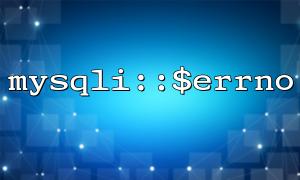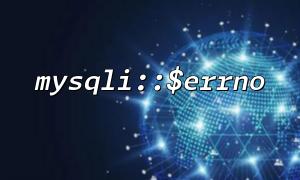When developing PHP applications involving database interactions, the capture and handling of database operation errors is crucial. In order to ensure that the system can respond promptly and issue alarms when an error occurs, we can use the mysqli::$errno function to perform error monitoring and alarm configuration. This article will explain in detail how to integrate this feature in a database monitoring alarm system.
mysqli::$errno is a property of the mysqli class, indicating the error code of the most recent MySQL operation. When performing a database operation, if an error occurs, the property contains a specific error number. You can perform further error handling or alarm based on this error number.
$mysqli = new mysqli("localhost", "user", "password", "database");
if ($mysqli->connect_error) {
echo "Connection error (" . $mysqli->connect_errno . "): " . $mysqli->connect_error;
}
In the example above, if an error occurs while connecting mysqli , $mysqli->connect_errno will return an error code, which you can trigger the alarm mechanism based on.
In order to monitor and alert in a timely manner during database operations, we can combine mysqli::$errno to achieve this requirement. Specifically, the following steps can be used:
Every time you interact with the database, you should check mysqli::$errno to determine whether an error has occurred. For example, when executing a query or inserting data, we can record error messages when an error occurs and trigger an alarm.
$query = "SELECT * FROM users";
$result = $mysqli->query($query);
if ($mysqli->errno) {
// When an error occurs,Record error information
error_log("MySQL Error code: " . $mysqli->errno . " error message: " . $mysqli->error);
// Trigger alarm
sendAlert($mysqli->errno, $mysqli->error);
}
When a database error is detected, an alarm can be sent through the sendAlert function. This function can notify the administrator by email, text message, or other means. Here we use email to send alarms as an example:
function sendAlert($errno, $error_message) {
$to = "admin@m66.net"; // Administrator email
$subject = "Database error alarm";
$message = "A database error occurred,Error code: $errno,error message: $error_message";
// Send an email
mail($to, $subject, $message);
}
Sometimes, database errors can be temporary problems due to the normal operation of the system, such as connection timeouts, etc. To avoid frequent alarms, we can set an alarm threshold, which will only trigger an alarm if the number of errors exceeds a certain limit.
// Number of errors recorded
$alertThreshold = 5;
$errorCount = 0;
// 假设When an error occurs会执行下面的代码
if ($mysqli->errno) {
$errorCount++;
// If the number of errors exceeds the threshold,Send an alarm
if ($errorCount >= $alertThreshold) {
sendAlert($mysqli->errno, $mysqli->error);
$errorCount = 0; // Reset error count
}
}
Different types of database errors may require different handling methods. For example, connection errors and query errors may have different alarm policies. You can distinguish error types based on error codes and take different measures.
if ($mysqli->errno) {
switch ($mysqli->errno) {
case 1045: // Permission Error
sendAlert($mysqli->errno, "Permission Error: " . $mysqli->error);
break;
case 2002: // Connection error
sendAlert($mysqli->errno, "Connection failed: " . $mysqli->error);
break;
default:
sendAlert($mysqli->errno, "Unknown error: " . $mysqli->error);
}
}
Here is a simplified version of the complete code example that demonstrates how to implement database monitoring alarms using mysqli::$errno :















